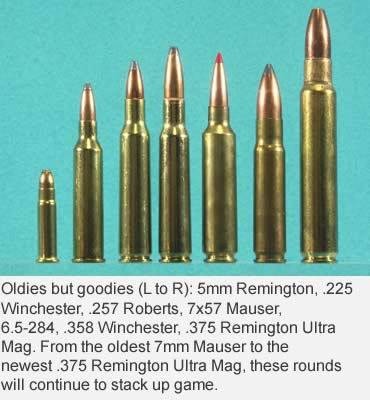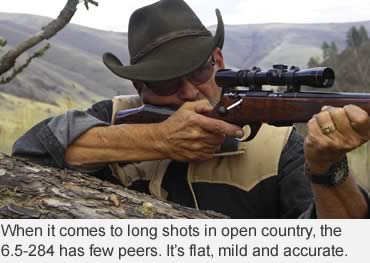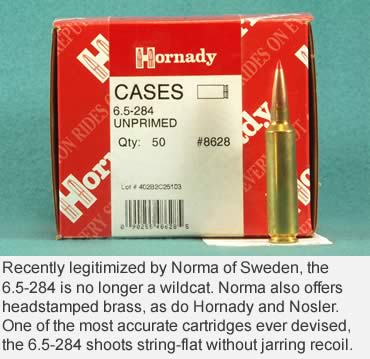By Ralph M. Lermayer
In the rush to own the latest hunting rounds, we all too often pass by some great performers that have been with us for decades.
Who are you going to ask to the prom, the prettiest gal in school or the one whose father has the best deer hunting property?
Tough call. It’s sort of like asking, “Which is better, sizzle or steak?”
Answers to a similar question has affected the popularity, longevity and success of a whole stack of rifle cartridges. Rounds high in performance have fallen by the wayside as cartridges with a lot more sizzle, but not necessarily any better, bypassed the better performers known to deliver the goods.
Here’s a look at some of those also-rans that have been relegated to wallflower status.
The 5mm Remington
A rimfire pushing a .204 caliber (5mm), 38-grain bullet at 2,100 fps? Sounds like a 100-yard rabbit killing machine. It was. It showed up on the shelves in 1970, and Remington chambered two of their proven .22 rifles for it: the clip-loading Model 591 and the tube-fed 592.
Good rifles, good ammo, but, for some reason, no one else loaded the round or chambered a rifle for it, although Thompson/Center made a few Contender barrels. Hunters who bought those guns loved them, and many a 5mm rifle owner still hangs onto it, wishing the now-obsolete ammo will appear again, maybe in a less destructive full metal jacket option.
There was a burst of hope when Hornady’s .17 HMR hit the shelves and shook things up, becoming an instant success. Calls to bring back the 5mm filled the halls at Remington’s Ilion, N.Y., factory. The time was obviously right, but no dice. Manufacturing or possibly technical problems seem to stand in the way of reintroducing this great rimfire, but, who knows? We can hope.
.225 Winchester
 There has always been a gap between the popular .223 Remington and the workhorse .22-250 Rem. Often, those of us who regularly pack a .223 wish we had just a little bit more oomph. But when smaller targets show up close, those wielding a .22-250 know we’re about to mess up a whole pile of meat or hide. The answer lies somewhere in the middle, and the .225 Winchester is the solution.
There has always been a gap between the popular .223 Remington and the workhorse .22-250 Rem. Often, those of us who regularly pack a .223 wish we had just a little bit more oomph. But when smaller targets show up close, those wielding a .22-250 know we’re about to mess up a whole pile of meat or hide. The answer lies somewhere in the middle, and the .225 Winchester is the solution.
This semi-rimmed case was introduced in 1964, and its performance actually nipped the .22-250 and venerable .220 Swift in the butt. Unlike those, it proved effective with bullet weights from 40 to 70 grains and is easily capable of pushing the lighter bullets to that elusive 4,000 fps. Factory loads routinely drive a 55-grain bullet to 3,500 fps.
Performance was slick as butter in the Model 70, and the small rim made it a natural for a single-shot or lever gun. The .225 Winchester is so good, I would not be surprised to see it offered again as the interest in predator hunting continues to grow. It is a real sleeper in today’s great cartridge lineup and too good to be gone.
.257 Roberts
The search for the perfect hunting cartridge has been ongoing since the first cartridge was loaded at the tail end of the muzzleloading era. Many believe the perfect round has been right under our noses since Remington legitimized the .257 Roberts in 1934.
When all the pieces come together, bore diameter, case capacity and shoulder angle, magic happens! You wind up with inherent accuracy, mild recoil, and long barrel and case life. The .257 Roberts is considered by many to be as close to the ideal hunting cartridge as has ever been produced. I gave one to my new bride many years ago, and, over time, watched it stack up cords of game.
Just last week, its roar woke me from a midday snooze as it stacked up yet another coyote that dared set foot in her pasture. No matter if you’re hunting predators, antelope, mule deer or whitetails — or even elk and caribou — a 50-grain bullet at 3,800 fps or a 120-grainer at close to 3,000 fps will get the job done.
Still occasionally chambered, the .257 Roberts is all the gun most hunters will ever need.
7x57 Mauser
I guess there’s a difference in the mindset and objectives of those who design cartridges for the military and those who are going for the sporting market. The military guys want a cartridge that is mild on the shoulder, easy on hardware, accurate and just kills stuff at any practical range.
That was the goal in 1892 when Mauser introduced the 7x57, or Spanish Mauser. It didn’t take long for the hunting community to figure out they had the same objectives, and a classic field cartridge was born. Like its sibling, the .257 Roberts, it has been called a near-perfect, all-around hunting round with a bit more punch than the .25 bore.
Capable of driving a 100-grain 7mm bullet at 3,300 fps, or a 140 at 2,900, this case is balanced, accurate and a pussycat in the recoil end. Factory loads from 140 to 175 grains are still available, but you’ll have to hunt for them. Handloaders can have a field day with today’s wide selection of high-tech 7mm bullets. While today’s sporting case designers go after the sizzle in new introductions, this vintage round should be guiding their efforts. You only need see it perform once, and you’re a convert. It’s a great and very useful cartridge by any measure, and those who own one know it.
6.5-284 Norma
 The quest to reach out just a little bit farther has been a driving force in new cartridge development. Unfortunately, farther usually means more power, and that translates to cases with more roar, bellow and recoil. What would happen if, instead of relying on more horsepower, we instead chose a bullet whose diameter, shape and design gave it an aerodynamic edge? In other words, a bullet designed to best buck the elements with minimal drop due to its shape, and matched to the perfect case capacity. The result would a 1,000-yard shooter that barely nudges the shoulder. These are exactly the attributes of the 6.5-284 Norma, a case that’s impacting the 1,000-yard benchrest world.
The quest to reach out just a little bit farther has been a driving force in new cartridge development. Unfortunately, farther usually means more power, and that translates to cases with more roar, bellow and recoil. What would happen if, instead of relying on more horsepower, we instead chose a bullet whose diameter, shape and design gave it an aerodynamic edge? In other words, a bullet designed to best buck the elements with minimal drop due to its shape, and matched to the perfect case capacity. The result would a 1,000-yard shooter that barely nudges the shoulder. These are exactly the attributes of the 6.5-284 Norma, a case that’s impacting the 1,000-yard benchrest world.
While a 6.5 bore (.264) might not be a popular diameter in the U.S., where the .30 (.308) reigns supreme, Europeans dote on it. Falling right between our beloved .25 and .30 bores, it is truly a better choice ballistically.
It’s based on the rebated rim case that Winchester designed for lever guns and semiautos in 1963. It didn’t take the wildcat crowd long to match it to a 6.5 bore, and the genie was out.
Velocity figures might appear ho-hum, but results don’t lie. It shoots flat. As one old Texas shooter once told me, “It shoots flat to 300 yards, then raises a mite.” That’s an exaggeration, of course, but the 6.5-284 is one of the best-performing long range cartridges ever devised, shooting everything from 95- to 160-grain bullets string-flat without excessive recoil.
 Both Norma and Nosler load it and offer headstamped brass, so it is no longer a wildcat. NoslerCustom, Blaser and Cooper Firearms offer 6.5-284 rifles. T/C Encore owners can get barrels thus chambered from the T/C Custom Shop.
Both Norma and Nosler load it and offer headstamped brass, so it is no longer a wildcat. NoslerCustom, Blaser and Cooper Firearms offer 6.5-284 rifles. T/C Encore owners can get barrels thus chambered from the T/C Custom Shop.
.358 Winchester
There are two types of gun writers. Those who like to get out and hunt, and those who do most of their hunting on a keyboard. Since its introduction in 1955, gun writers who hunt a lot have been praising the virtues of this great round, while the others give it short shrift. What do they know?
From deer to moose, in close or out to 250 yards, this is a performer. Heavy, well-constructed bullets at medium velocities hit with sledgehammer-like authority and smash through bone and hide. That is the legacy of the .358 Winchester, and it does it without a lot of recoil!
It’s just a necked-up .308, introduced at the same time the necked-down .308, the .243, was released. It is far the more useful of the two, but try as we might to sing its praises, it stays second string.
Rifles are hard to come by unless you build one, although Winchester, Ruger and even Remington have released limited chamberings. Browning’s BLR in .358 Win is still available, but only in limited runs. Lots of used guns are out there, but they’re hard to find because those who own them know how well they perform and don’t turn them loose.
Factory loads are limited to 200-grain bullets, but handloaders can stoke them with a mild 180-, a 200-, 225- or a 250-grain load, depending on what they’re hunting. Nothing I’ve ever hit with either of my two .358s has ever taken a second step. What does that tell you?
.375 Remington Ultra Mag
Most of the cartridges we’ve dealt with here have been forgotten or overlooked, better suited to the general kind of hunting most of us do: varmints to big deer. There are, however, those who push the envelope and take on game with attitude, usually bad attitude.
Moose are big. If you catch one on dry ground, you want to drop him where he stands or you’ll be quartering an animal bigger than a horse in cold, knee-deep muck and water. Big bears are also best stopped and downed right now, and there’s no telling what bad-tempered set of fangs or horns you’ll run into in Africa.
There’s a need for muscle, and what I like to call “excessive show-stopping force,” and Remington’s .375 Ultra Mag might well be the best cartridge ever designed for such cheeky situations.
The Ultra Mag series began when Remington decided to see how much case they could get in the standard long action. The vintage .404 Jeffery case, a .40-caliber powerhouse, was selected, and it was necked down to .308. That created the .300 Remington Ultra Mag and launched a whole bunch of further experiments. One of the least-known but most ballistically successful happened when they necked the case down to .375. That cartridge, the .375 Remington Ultra Mag, surprised everyone by outperforming the venerable .375 H&H, shooting a .275-grain bullet at an impressive 2,900 fps and a 300-grain bullet to 2,700. That gave it a trajectory as flat as a .270 shooting 150-grain bullets, and it delivers it from a standard-length, reasonably priced rifle.
The biggest surprise, however, goes back to balance. It is far more accurate and efficient than any previous .375, so much so that it has become the new standard test rifle used by bullet manufacturers when they test .375 bullets. While the big Weatherbys and .458s are still relied on worldwide, the .375 from Remington will do anything they do in a standard action. This sleeper will someday become the new standard when muscle is the mandate.
Delivering The Goods
We’ve come through an era when your rifle was measured by its ability to deliver a family’s sustenance. It was considered a vital tool, kept at the ready, well maintained and judged solely by its performance. The cartridges that were chosen were measured by that same standard, not by glowing reports published by couch hunters. The cartridges included here have been tested, measured and proven in the real world, and they’ve all made the grade. Should you, by chance, stumble upon one of these, don’t let it get away.
This article was published in the October 2009 edition of Buckmasters GunHunter Magazine. Subscribe today to have GunHunter delivered to your home.